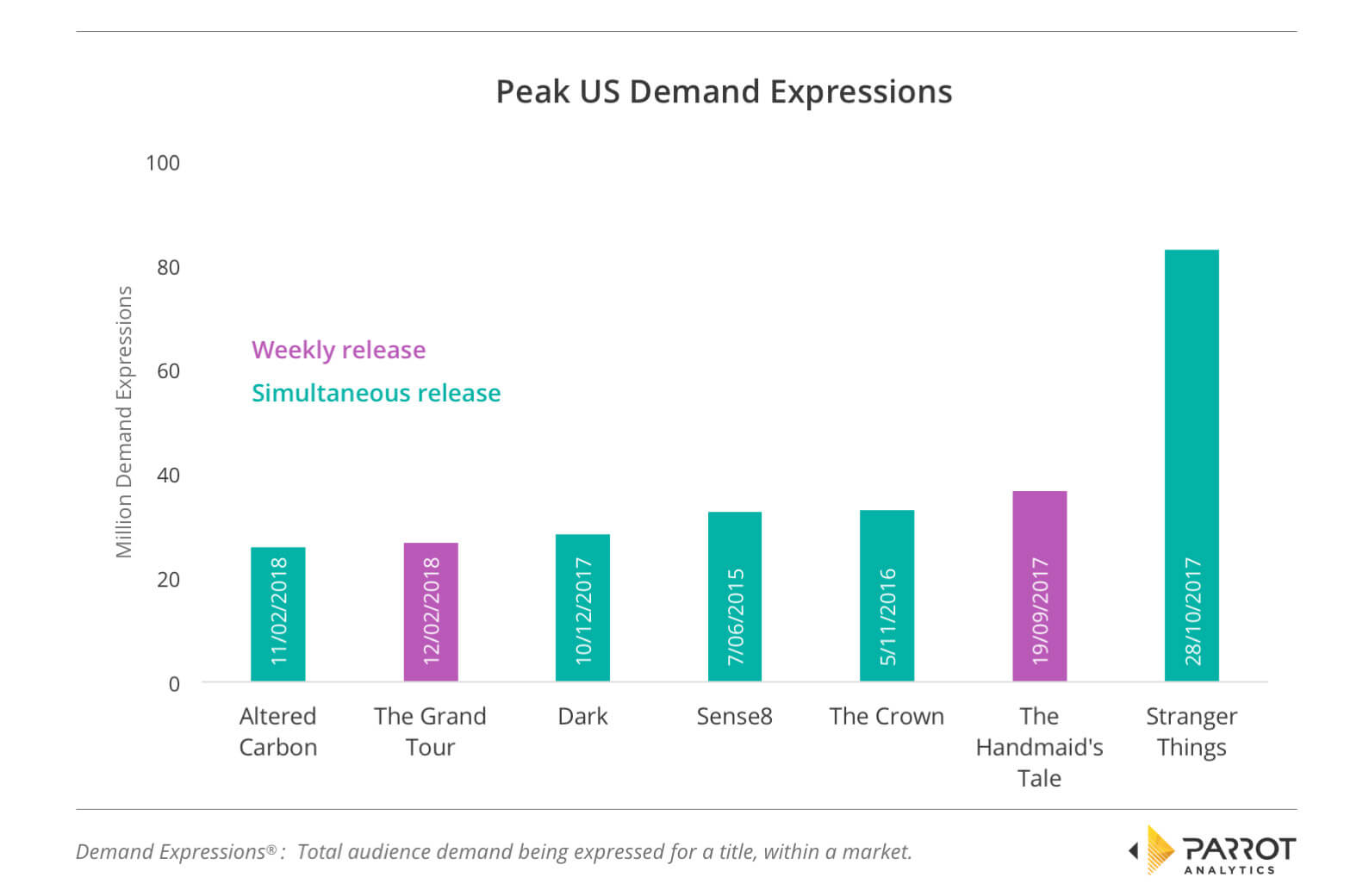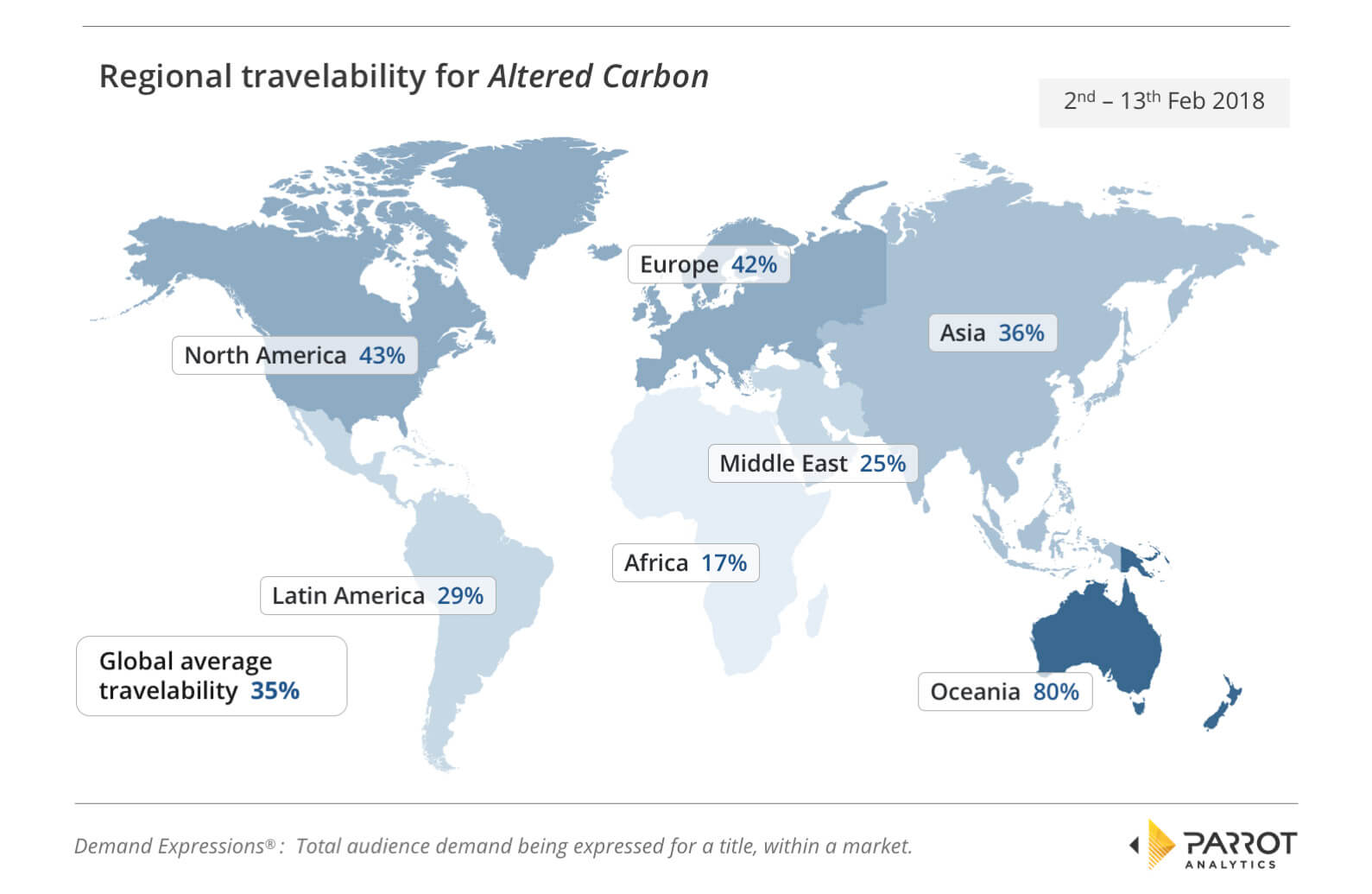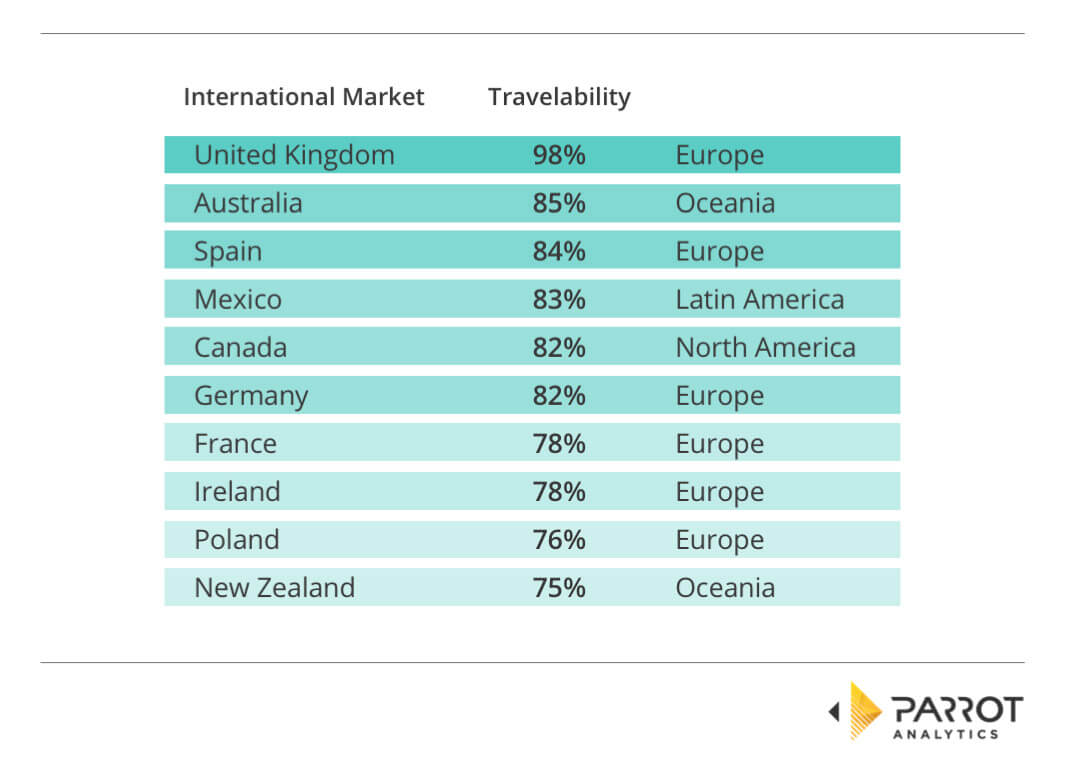Image: Altered Carbon, Netflix
Released worldwide on February 2nd 2018, cyberpunk thriller Altered Carbon is Netflix’s latest big-budget digital original series. Reportedly costing $6-7 million USD per episode, has it gained the audience to match this level of investment?
Parrot Analytics has leveraged its global demand dataset to find out how Altered Carbon is performing after release, how that performance compares to similar Netflix series and what this might mean for the show’s future.
How does the peak release demand for Altered Carbon compare to other high-profile streaming shows?
Netflix overwhelmingly tends to release all the episodes of a show simultaneously and Altered Carbon was no exception: All ten episodes were made available to Netflix subscribers worldwide at the same time. With a few notable exceptions such as the sleeper Stranger Things season one, this release strategy generally results in high peak demand that returns to baseline demand within a month or so.
Conversely, weekly releases tend to have lower peak demand but sustain their demand growth over the whole length of the airing. From this, an interesting metric to look at is the peak demand observed for a series.
The below chart presents the highest recorded demand since 2015, and the date this peak demand was observed for Altered Carbon and other high-profile streaming series:
So far, Altered Carbon has a peak of 25.8 million Demand Expressions. This peak was recorded for the 11th of February which was nine days and the second Sunday after the show’s release. The peak occurring at this point is likely due to two factors: The first being that a large portion of fans will have completed their first viewing while the second is that after a week of hearing about the show from friends and colleagues, people decided to try the show over that weekend.
It must be noted that the comparison titles in the above chart are extremely strong: Stranger Things is the current global record holder for all digital originals’ peak demand, while The Grand Tour and The Handmaid’s Tale are the most in-demand original series on Amazon Prime and Hulu, respectively.
However, the maximum US demand is just one metric to examine: We have a prior example of a high-profile, expensive Netflix sci-fi series in the form of Sense8 that gives us clues as to what is important to the streamer. While that show did not meet Netflix’s expectations and was cancelled after two seasons, Netflix did state that it performed better internationally than it did in the US.
How does the global release demand for Altered Carbon compare to similar Netflix titles?
With a recent Netflix end-of-year statement revealing that the service now has around 8 million more international than domestic subscribers, a strong international performance for Altered Carbon could mean the show is considered a success at Netflix.
The following graph shows the global daily demand for four Netflix series with strong international appeal. For ease of comparison, the demand is time-shifted to align the release dates of each title’s most recent season.
This gives a more accurate view of the value of Altered Carbon to Netflix. Importantly, note that as all episodes of Netflix dramas are released simultaneously, significant demand increases more than 2 weeks after the release date are rare.
After nearly two weeks of availability, the average demand worldwide for Altered Carbon is very close to the demand for Sense8 the same number of days after that show’s season 2 release.
We also observe that the release peak for Altered Carbon is smaller than the peak for Sense8 season 2, but that makes sense, as Sense8 was a returning show with an existing fanbase, while Altered Carbon is new to TV. However, it is clear that Altered Carbon did not gain as much global appeal thus far as German sci-fi series Dark, or historical drama The Crown.
Does Altered Carbon appeal to important regional niches?
As an international service, one final factor that Netflix may consider is whether Altered Carbon has high demand in parts of the world where the service is currently trying to improve its appeal. The show lends itself to this: The main character is half-Polish half-Japanese, the lead actress is very popular in Mexico and the futuristic setting of the show in general has many international influences that should appeal to various parts of the world.
To get a detailed picture of international demand for Altered Carbon, we use Parrot Analytics’ standardized global industry metric, called travelability. This metric compares the demand in each country to the demand in the title’s home market, which for Altered Carbon is the USA.
The region that is most enthusiastic for Altered Carbon is Oceania, which has a travelability of 80% (meaning the region’s demand is 80% of the demand in the US), although that region is the smallest by number of markets.
Outside Oceania, the show performs best in North America and Europe, which have a content travelability index of 43% and 42%, respectively. This is also made apparent when the ten individual countries with highest travelability are considered: Apart from both Oceanic countries, the top ten has 7 countries from Europe and North America in it, with the remaining country being Mexico.
As mentioned earlier, Altered Carbon co-stars a Mexican actress and features Mexican traditions like The Day of the Dead. Factors like these appealed to Mexican audiences and helped the show gain a travelability of 83%, making Mexico the fourth best international market for the show.
However, that Mexican enthusiasm did not carry over to other markets in the region. The second highest market by travelability in Latin America is Brazil, which with 63% travelability is a full 20% below Mexico. Overall, the Latin American travelability for Altered Carbon is 29%, 6% lower than the global average. Given the strong influence of Mexican culture on the show and the strength of the streaming service in the region, there exists ample room to grow the show’s footprint in Latin America in support of new subscriber acquisition and subscriber retention efforts.
In Asia we observe a result of 36% for the region’s travelability, around the global average. Asia’s result is mostly buoyed by two countries: The Philippines has a travelability of 65% while China has a travelability of 64%. Given the large size of the audiences in these markets, this may be enough for Netflix to consider the show a success in the region.
Despite this success, it is currently unclear what the future of Altered Carbon will be. None of the metrics examined point to Altered Carbon being the undoubted hit that Netflix was likely anticipating, and the streamer has shown an increasing willingness to cancel shows it thinks are not working, especially high budget ones like The Get Down and Sense8.
However, both those titles were allowed a second season to try and get on their feet. Based on this, Parrot Analytics predicts that Altered Carbon may get a second season, but the pressure will be high on the producers to make that season count.





